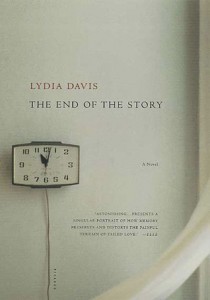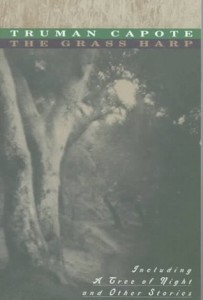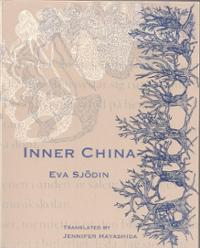This week Lydia Davis won the Man Booker International Prize and the world rejoiced–especially the world of short fiction (and short, short fiction) writers. Davis is a must-read in writing classes of all stripes. Although I’ve read a story or two of hers, it was her endearingly unrehearsed acceptance speech in which she defends translation (plus a bonus day off from work) that inspired me to finally open one of her books.
Beginning at The End of the Story
 The first novel by Lydia Davis, The End of the Story, is both a book about the end of a love affair and a book about writing a book. The first sentence folded into itself wonderfully, “The last time I saw him, though I did not know it would be the last…” The next couple of pages were spare and striking, but eerily familiar, like I’d read them before. It turns out that I had, and in fact Davis repurposed many of her shorts to compile this novel. I find that odd. Although I believe each writer has his or her obsessions and we write about the same themes over and over (sometimes even when we try not to), I like to think that each piece of work has a natural form that we are trying to shape the work into. This vague reworking of previous material seems like treating your own writing like “found” writing and I can’t imagine having the distance from my pieces to do that. But I also believe that Davis is in complete control of her tools, so I kept reading…
The first novel by Lydia Davis, The End of the Story, is both a book about the end of a love affair and a book about writing a book. The first sentence folded into itself wonderfully, “The last time I saw him, though I did not know it would be the last…” The next couple of pages were spare and striking, but eerily familiar, like I’d read them before. It turns out that I had, and in fact Davis repurposed many of her shorts to compile this novel. I find that odd. Although I believe each writer has his or her obsessions and we write about the same themes over and over (sometimes even when we try not to), I like to think that each piece of work has a natural form that we are trying to shape the work into. This vague reworking of previous material seems like treating your own writing like “found” writing and I can’t imagine having the distance from my pieces to do that. But I also believe that Davis is in complete control of her tools, so I kept reading…The Haze of Memory
“I’m not sure whether we walked on dirt or asphalt, what we passed, or how he walked next to me, whether awkwardly or gracefully, quickly or slowly, close to me or a few feet away.” – Lydia Davis
One of the most interesting things Davis does in this book is describe a shifting space of memory where she at once enumerates possibilities and signifies that the details themselves are unimportant. It’s accurate to the experience of memory, but I’m not sure it served the narrative for me because the details were so hazy that I had trouble engaging with the story.
Narrative Monologues
“I am inefficient in the way I work on the novel and that inefficiency infects other things I try to do… I still become confused and forget what I was doing when I left off the day before. I have to write instructions to myself on little cards with an arrow in front of each. I look for the arrow, read the instruction, follow it…” – Lydia Davis
Interspersed with the story of a love affair from the past is the story of the narrator today as she writes the book about the love story. It could be an interesting device, but the prose is too accurate for my taste to the experience of day-to-day life. By that I mean that it feels unedited and it took some serious patience to endure the writing blow by blows. Worse yet were the sections about what’s happening in the present time that has no relation to the love story and no relation to writing about the love story. One passage goes into the types of grasses that grew in a meadow before it was turned into a townhouse. It could be poetic if I really wanted to compare her relationship to that meadow, but there are no parallels between the two except that both changed with time. I wanted to edit this all out so badly, but it had to be there for a reason… right?
Part of me hoped that it would develop into a full-blown metafiction, but instead it reads like a roman à clef, and not a very artful one at that. Technically, Davis is drawing attention to the book as a work of art (so you could call it a metafiction), but her writing about writing is more pained than pointed.
Turning Words into Images
“No address of his was good for very long and the paper in my address book where his address is written is thin and soft from being erased so often.” – Lydia Davis
Like Grace Paley, Davis has a way with detail. But Davis’ language is less concise than Paley’s (in the above quote, I would have deleted the whole first clause) and Davis often draws attention to a random object that isn’t otherwise significant in the story. This happens late in the story when the characters are quite broken up and the narrator mentions the grey hair on the sink that a house guest left. In a book where I was searching for something to hold onto, this treatment of significant detail was further disorienting and I couldn’t tell (and at times ceased to care) what was supposed to be important.
Scene vs. Summary
One of the things many readers have remarked on about this book is that there’s no dialogue. More importantly, there are barely any scenes. Usually in a novel, the writer summarizes wide swathes of narrative to move you quickly through unimportant moments and then starts adding in detail and slowing down time to indicate that you’re coming up on something important–a scene–a critical moment in the development of the plot. But just as significant details are thrown around willy nilly, Davis doesn’t develop scenes in the book. Everything is related from a distance that was one more reason I found it difficult to engage with the story.
Am I Just Jealous?
Yes. Although I’ve read this book (originally published in 1995), it is strikingly similar to the first draft of my second book–a draft I hated for its self-consciousness, its lack of story, and my failure to step outside of myself when writing it. Though The End of the Story has gotten mixed reviews and many say it’s simply not their favorite of her books, I couldn’t help but feel if I had presented my book as it was to anyone, I would have been lambasted for the things I’ve mentioned above.
But then again, maybe I’m not jealous, because before I even knew of this book, I chose to begin rewriting my book into something I’d like to read. Maybe Davis’ writing is too close to my own and I can’t love it (especially in this form) because I can’t step far enough away from it to see the art of what she’s done versus how I would have done it. Maybe I need to give her writing some space before approaching it again. Promise not to wait until she wins the Nobel.
If you want to decide for yourself whether I’m being too harsh, pick up a copy of The End of the Story from Bookshop.org. Your purchase keeps indie booksellers in business and I receive a commission.
 Maybe the reason you can’t go home again is that you can never see all of what it was—you could only glimpse one angle of it and as you age you see another and then another, but the place you grew up and the people you grew up with are amalgams of all the ways you see them over time. That’s how I felt when reading The Grass Harp by Truman Capote before, during, and after a trip to my hometown, Moscow, Idaho.
Maybe the reason you can’t go home again is that you can never see all of what it was—you could only glimpse one angle of it and as you age you see another and then another, but the place you grew up and the people you grew up with are amalgams of all the ways you see them over time. That’s how I felt when reading The Grass Harp by Truman Capote before, during, and after a trip to my hometown, Moscow, Idaho. Frequent readers of this blog will know how much I appreciate spare language. Inner China by Eva Sjödin and translated from the Swedish by Jennifer Hayashida shows brilliantly just how much horror can be wrought with the sparest of language. The story of two small children who hide in the woods to escape sexual abuse is remarkably restrained. And therein lies the power of this poetry.
Frequent readers of this blog will know how much I appreciate spare language. Inner China by Eva Sjödin and translated from the Swedish by Jennifer Hayashida shows brilliantly just how much horror can be wrought with the sparest of language. The story of two small children who hide in the woods to escape sexual abuse is remarkably restrained. And therein lies the power of this poetry.